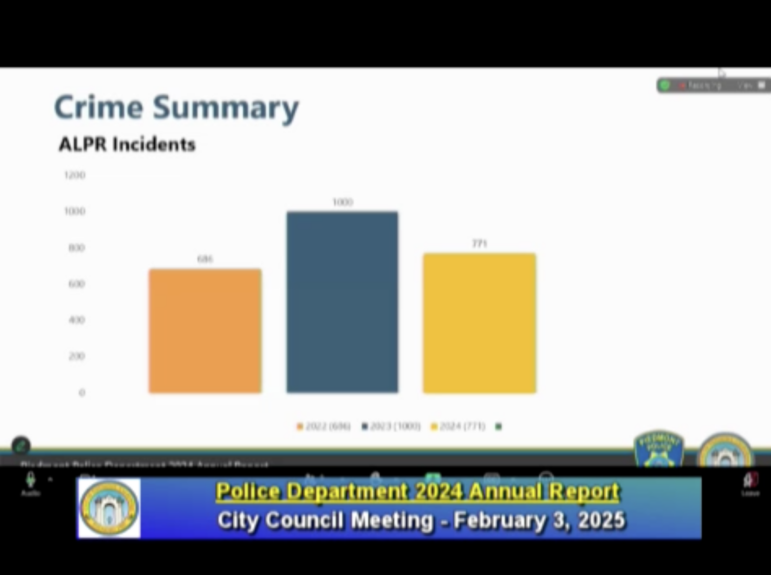Burglaries increased in the city last year, even as crime across the board dropped, said Piedmont Police Chief Jeremy Bowers in his annual report to City Council on Monday night.

The decline in reported offenses in 2024 as compared to 2023 was most notably due to decreases in robberies, larceny thefts, and assaults, the staff report said. Burglaries, defined generally as “the unlawful entry into a dwelling or specified structure with the intent to commit a theft or other felony”, increased from 47 reported incidents in 2023 to 76 reported incidents in 2024. “A lot of it is construction burglaries,” said Bowers. He said there was an opportunity to re-engage with the Planning Department around crime prevention on construction sites.
(To discourage burglaries, police say residents should ensure external doors are locked, keep property well-lit, and use technology such as cameras and home monitoring systems to deter burglars and aid investigations when burglaries do occur.)
Larceny-theft decreased from 337 reported offenses in 2023 to 206 reported offenses in 2024. Bowers said that drop was due to a regional effort via the Alameda County Regional Auto Theft Task Force to break up catalytic converter fencing rings. “We have in the past assigned an officer to that task force,” he said. “Even when we don’t have an officer there, [we] retain ties to the task force” and are able to benefit from intelligence the group collects, he said.
ALPR incidents
Piedmont has 48 ALPR cameras in the city, Bowers said, and sixteen of the city’s 405 arrests last year were arrests directly related to the ALPR cameras. The sixteen arrests do not include arrests made by detectives using ALPR and Public Safety Camera technology in follow up investigations, according to the staff report.
Bowers shared a slide that showed ALPR “incidents” over the last three years, one that showed a big increase in hits in 2023, followed by a drop in 2024. The increase in 2023 was due to the addition of more ALPR cameras, he said, but he said he thought the 2024 drop was due to an increase in “no-plate” cars — or cars with recently stolen plates that aren’t in the system yet — entering the city. He said ALPR technology is adjusting to this trend and the city is working to stay on top of new developments. Bowers said this was “absolutely” a case where criminals have become more aware of the deployment of cameras and were using workarounds.

Community outreach
In addition to the annual Coffee, Cops and Cars community event and new Bark in the Park programs aimed at pet owners, Bowers said the department’s Cop on the Block community outreach program was especially important. “It’s about getting officers out of their cars and learning about the intricacies of the different neighborhoods. Our community wants to see us and engage with us.”
The Annual Report is available for direct download HERE and can also be found on the Police Department Transparency Portal, which includes Department policies as well as data on ALPRs and a variety of other subjects.
Staffing study finds PPD uses its time and technology well, but could benefit from administrative help
In 2023 the police department made a multi-pronged effort to address a crime spike. A staffing study project was one element of that plan, and also provides the city and community with an opportunity to assess the department’s functioning and organization relative to future changes associated with increased housing, public safety demands, evolving technology and a key planning as the community considers future public safety facility needs.
Because the community was concerned about the staffing of sworn officers in 2023, the department enlisted the services of Matrix Consulting Group. Matrix has conducted operational and staffing assessments for over 400 police departments in California and across the country (as well as in Canada), according to the city’s staff report.
On Monday night, Matrix delivered its report to Councilmembers. Consultant Richard Brady highlighted some key findings:
*Piedmont, due to its small size, has a unique call service pattern — the calls are mostly community support related instead of a response to crime. He said the department fielded around 15 calls a day, and 75% of those calls fell into the community support category (i.e., vacation checks, parking complaints, suspicious behavior, security checks, and so on.)
*Major crimes are not common in Piedmont, but property crimes are increasing. Brady said lack of evidence and witnesses to thefts and burglaries makes it hard to work cases, and suggests the department could have more directed patrols.
*How officers work with the community — use their “proactive” time — is a better measure of their effectiveness, he said. Brady said that Piedmont has an “exceptional level of service capability” — as much as 82% of the time available every hour of the day for proactive work. The good news, he said, is that Piedmont uses that time well to address community problems, citing work with schools, and community outreach programs.
*Brady suggested adding a crime analyst and an administrative sergeant to allow sergeants to be in the field more. Matrix also said that Piedmont could add additional staff — up to three in the dispatch center for example. Having only a single dispatcher on duty is a challenge for many small departments, he said — hard to take a break or find a substitute if necessary. He said some departments turn to a regional model to address this issue.
*Piedmont’s use of Information technology is strong, Brady said. ALPRs and public security cameras are “force multipliers” that Piedmont uses to its advantage.
“This is a tool and an aide, not a literal road map,” Bowers told the Council at the report’s conclusion. “We have people wearing multiple hats, as happens in small departments. Fiscal restraints, real world realities and community expectations” will dictate how the department addresses the issues raised.
